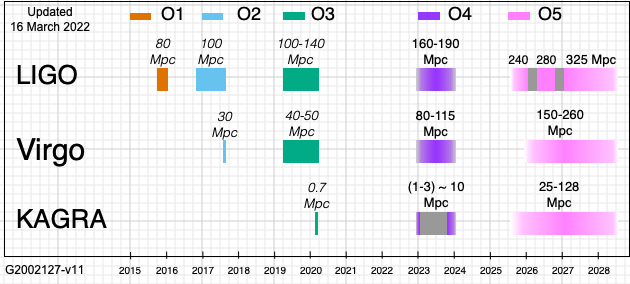LIGO, VIRGO AND KAGRA OBSERVING RUN PLANS
[15 May 2022 update; next update by 15 July 2022]
LIGO, Virgo, and KAGRA are closely coordinating to start the O4 Observing run together. We plan to start the O4 Observing run in mid-December 2022, with an Engineering Run to start in mid-November; low-latency alerts for candidate events identified during engineering time may be released, both to exercise the system and to exploit their scientific value.
At present, the run is planned to start with only LIGO Hanford, Virgo, and KAGRA. While the commissioning of the detectors is progressing, the plan towards readiness is being reviewed. The completion of LIGO Livingston’s upgrades is taking longer than planned. We project that Livingston could join the run in February 2023, but we are looking into options to reduce the delay.
The projected sensitivity of the detectors remains unchanged: LIGO projects a sensitivity goal of 160-190 Mpc for binary neutron stars. Virgo projects a target sensitivity of 80-115 Mpc. KAGRA should be running with greater than 1 Mpc sensitivity at the beginning of O4, and will work to improve the sensitivity toward the end of O4.
Timeline
The gravitational-wave observing schedule is divided into Observing Runs of operation at a given sensitivity of roughly a year duration, down time for construction and commissioning, and transitional Engineering Runs between commissioning and observing runs. The current best understanding of the long-term observing schedule is shown below. Since BNS (Binary Neutron Star) mergers are a well-studied class of gravitational-wave signals, this figure gives the BNS range for each observing run.

During O4, we expect that four facilities (LIGO Hanford (LHO) and Livingston (LLO), KAGRA and Virgo) will observe for one year with a month break in the middle. KAGRA is expected to start with Virgo and LIGO, and then step away for commissioning and return to observing with a greater sensitivity toward the end of the O4 run.
The O5 start dates, duration, and sensitivities are current best guesses, and will likely be adjusted as we approach that run.
